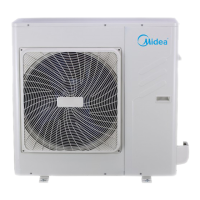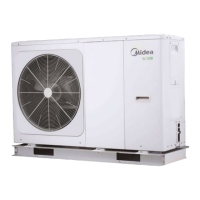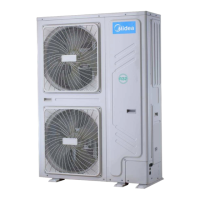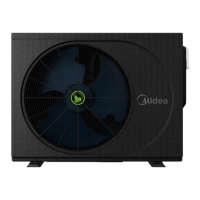Do you have a question about the Midea M-thermal Split MHA-V10W/D2N8 and is the answer not in the manual?
Explains the meaning of DANGER, WARNING, CAUTION, and NOTE symbols used in the manual.
Details symbols displayed on the unit related to flammable refrigerant and manual references.
Specifies the refrigerant type (R32) and its Global Warming Potential (GWP).
Table detailing the factory-charged refrigerant volume in kg and CO2 equivalent for different models.
Details requirements for height difference, pipe length, and bends in refrigerant piping.
Describes using soap water or a detector to check for leaks at joints.
Provides pipe sizes (gas and liquid) for different models.
Explains the flaring connection method for both gas and liquid pipes.
Details the process of charging nitrogen for airtight testing.
Guides on selecting wire diameters based on rated current using provided tables.
Specifies requirements for circuit breakers, including contact separation and residual current devices.
Details requirements for refrigerant charge limits in unventilated areas based on room size.
Details causes and corrections for errors related to condenser, ambient, suction, and discharge temperature sensors.
Explains causes like loose wiring or interference and suggests corrective actions for H0 error.
Lists causes like power issues or loose connections and suggests corrective actions for H1 error.
Details causes like low refrigerant, dirty heat exchanger, or valve issues and their corrective actions.
Explains causes like low water flow or overcharging refrigerant and their corrective actions.
States reasons similar to P1 and low voltage, suggesting corrective actions.
Lists sensor connection issues and suggests corrective actions for P4 error.
Details causes like narrow space, dirty heat exchanger, or loose wires and their corrective actions.
Details causes related to power supply, main board, or inverter board and suggests corrective actions.
Explains the meaning of DANGER, WARNING, CAUTION, and NOTE symbols used in the manual.
Details symbols displayed on the unit related to flammable refrigerant and manual references.
Specifies the refrigerant type (R32) and its Global Warming Potential (GWP).
Table detailing the factory-charged refrigerant volume in kg and CO2 equivalent for different models.
Details requirements for height difference, pipe length, and bends in refrigerant piping.
Describes using soap water or a detector to check for leaks at joints.
Provides pipe sizes (gas and liquid) for different models.
Explains the flaring connection method for both gas and liquid pipes.
Details the process of charging nitrogen for airtight testing.
Guides on selecting wire diameters based on rated current using provided tables.
Specifies requirements for circuit breakers, including contact separation and residual current devices.
Details requirements for refrigerant charge limits in unventilated areas based on room size.
Details causes and corrections for errors related to condenser, ambient, suction, and discharge temperature sensors.
Explains causes like loose wiring or interference and suggests corrective actions for H0 error.
Lists causes like power issues or loose connections and suggests corrective actions for H1 error.
Details causes like low refrigerant, dirty heat exchanger, or valve issues and their corrective actions.
Explains causes like low water flow or overcharging refrigerant and their corrective actions.
States reasons similar to P1 and low voltage, suggesting corrective actions.
Lists sensor connection issues and suggests corrective actions for P4 error.
Details causes like narrow space, dirty heat exchanger, or loose wires and their corrective actions.
Details causes related to power supply, main board, or inverter board and suggests corrective actions.











